The Great Depression was a time of scarcity-induced innovation: families had to do without many household staples and used their resourcefulness to come up with alternatives made from goods that were more readily available. From dying their legs with tea in lieu of stockings to mending shoes with cardboard, the families of the Great Depression used what they had to make up for shortages of practically every food and good. This led to the appearance of some weird Great Depression foods survivalists and preppers use even today.
Nowhere was Great Depression ingenuity—and desperation–more apparent than in the average American kitchen. Spurred on by First Lady Eleanor Roosevelt, who encouraged families to save money and resources by practicing savvier home economics and repurposing household items, the Great Depression produced some truly disgusting food combinations. Not all the dishes that came from this time were short-lived, however; mega food companies like Kraft used the new normal as a platform to make their products, like mac ‘n cheese, a household staple for generations to come.
Although most of the dishes on this list aren’t for the faint of heart—or the weak of stomach—these dishes represent the true American spirit of resiliency and, for better or worse, creativity.
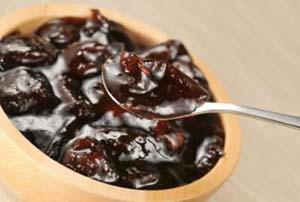 1) Prune Pudding
1) Prune Pudding
This simple dessert was made famous when Eleanor Roosevelt persuaded her husband, President Franklin Delano Roosevelt, to serve the dish to guests who were invited to the White House. Prunes were easy to store, widely available, and much less expensive than other fruits, while providing needed nutrients to the Depression-era diet: the fruit is packed with fiber and supplies almost one-third of your daily needs for Vitamin K.
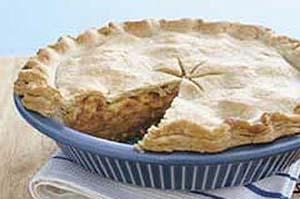 2) Mock Apple Pie (No Apples)
2) Mock Apple Pie (No Apples)
Apples weren’t readily available in the Great Depression, yet Americans weren’t willing to give up their cherished apple pie. Enter “mock apple pie” which substituted apples for crumbled crackers sprinkled with flavored syrup and cinnamon, all baked into a crust. The most famous of these recipes appeared on the back of the Ritz cracker box in 1934: “Ritz mock apple pie” was an instant hit.
3) Spaghetti and Carrot Casserole
Casseroles were wildly popular in the Great Depression: by combining all sorts of leftovers into one dish, families could increase the variety of their menu without needing to incorporate hard-to-find items. At the time meat was, for most, an unaffordable luxury so in this spaghetti casserole, boiled carrots were substituted for pricier meatballs and the whole concoction was then covered in white sauce.
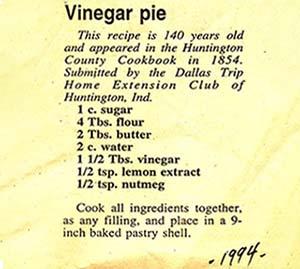 4) Vinegar Cobbler
4) Vinegar Cobbler
This dessert substituted a large amount of vinegar for more expensive fruit, in addition to water, a small amount of sugar, vanilla and butter as the filling.
Related: 5 Commitments You Must Make Before the Next American Depression
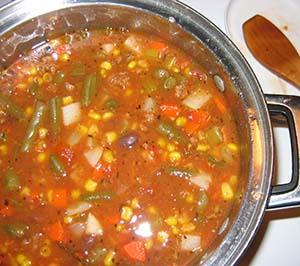 5) Mulligan Stew
5) Mulligan Stew
“Mulligan stew” is a term used for stews created by the homeless during the Depression. As the recipe varied depending on what food was on hand, the “stew” can be thought of as throwing anything and everything you had in the pot to fill your belly. Some down-on-their-luck folk went so far as adding lint to the pot to make it more filling.
6) Loaves
When the food shortages began, meatloaf was already a diet staple. Another example of a food that had to be tweaked to accommodate the scarcity of the new normal, meatloaf became “anything” loaf… from meatless meatloaf made with everything from peanuts to raisins to liver loaf, families used their creativity and whatever was available to make this alternative to the weekly favorite.
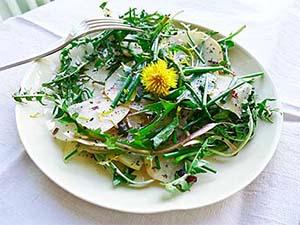 7) Dandelion Salad
7) Dandelion Salad
A dish that is a favorite of preppers and wilderness experts alike, dandelion salad is nutritious and can be made with simple greens foraged from any neighborhood. With salt, pepper, and vinegar to taste (when available), dandelion salad was both tasty and a way to add vital nutrients to the dinner menu without spending a cent.
Related: How to Make Dandelion Bread (With Pictures)
8) Kraft Macaroni and Cheese
Kraft Foods introduced its iconic macaroni and cheese in 1937, selling 8 million boxes its first year of production. The simple to make pasta dish provided 4 servings of food for $0.19 each, making it a cheap and easy way to fill empty bellies.
7) Jell-O
Gelatin surged in popularity during the Great Depression, with Jell-O leading the pack as the most popular. Gelatin (and Jell-O in particular) was marketed as a way to treat yourself to something “fancy” and often gave its relatively simply recipes exotic names. Much more affordable than pies, a handful of peanuts or a cherished piece of fruit could be turned into a gelatinous masterpiece worthy of the holidays with little expense.
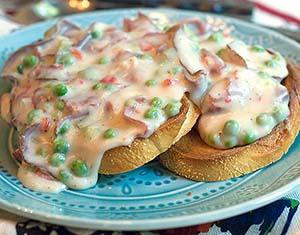 8) Creamed Chipped Beef
8) Creamed Chipped Beef
One of the most famous foods on the list, creamed chipped beef is affectionately known by many World War II veterans as “s**t on a shingle.” The chipped beef was covered in gravy and served on a piece of toast. When chipped beef was not available, other meats were substituted.
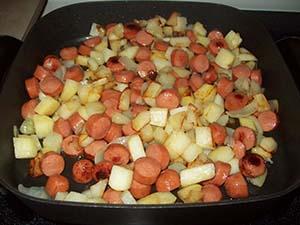 9) Poor Man’s Meal
9) Poor Man’s Meal
Both potatoes and hot dogs were inexpensive and easy to find; both make an appearance in this Great Depression meal. By frying up potato slices and adding a few hot dog pieces, families could get a filling meal without using scarce and expensive ingredients.
Related: Canning Amish Poor Man’s Steak
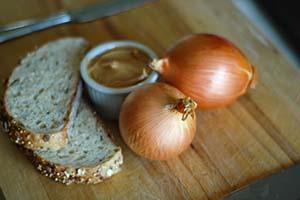 10) Peanut Butter Stuffed Onions
10) Peanut Butter Stuffed Onions
Created by the Bureau of Home Economics, this dish was well-known only for it’s bizarre taste. Baked onions were “improved” with scoops of peanut butter as filling, resulting in a disgusting and much disliked period food.
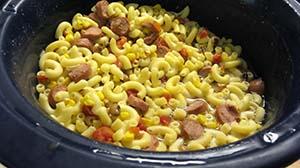 11) Hoover Stew
11) Hoover Stew
Like many other stews of that time, this recipe changed depending on what ingredients were on hand. Hoover stews (named after President Hoover) were mostly given out in soup kitchens and consisted of very thin broth with hot dogs, pasta, and any vegetables available.
 12) Italian Ice
12) Italian Ice
Italian ice was popular during the time because of its similarity to ice cream, without the addition of costly ingredients like cream and rock salt. This frozen treat was inexpensive and helped stave off the heat during the long summer days.
13) Potato Pancakes
Because of the wide availability and low cost of potatoes, Depression-era cooks used potatoes as substitutes in other dishes. Potato pancakes, made with grated potatoes cooked or fried in a pan, was a common dish at every meal.
Related: How To Make Potato Flakes With 5 Years Shelf Life (without refrigeration)
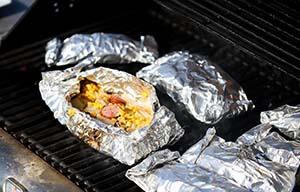 14) Tin Foil Hobo Dinners
14) Tin Foil Hobo Dinners
Hobo dinners, named after the homeless who lived in shantytowns near the railroad tracks, were a favorite because they could be cooked over an open fire. A square of tin foil was filled with meat, potato, onions, and other ingredients and thrown on top of the fire to cook for approximately half an hour.
15) Great Depression Casserole
Last on our list is the Great Depression casserole, which features bologna as the prized ingredient. With other budget-friendly ingredients like pork and beans and onions, this casserole was filling and could be altered to fit any budget.
Final Thoughts
The Great Depression was a very tough time for all people affected. We saw so many forced to change the way they lived, adapt, or die. There were items that practically vanished from the shelves and even livestock was affected.
By being aware of the Depression Era foods that were a staple back then, we can be better prepared for the future. In the highly unwanted event in which we are forced to get back to our roots, knowing what the Amish ate back then and how everyday people fought the hunger can help us remain alive.
You may also like:
1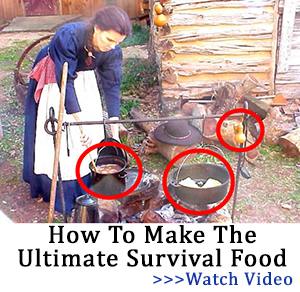 0 Food Lessons from the Great Depression
0 Food Lessons from the Great Depression
DIY Back Up Generator (Video)
Your Great Depression Era Recipe for Hard Times

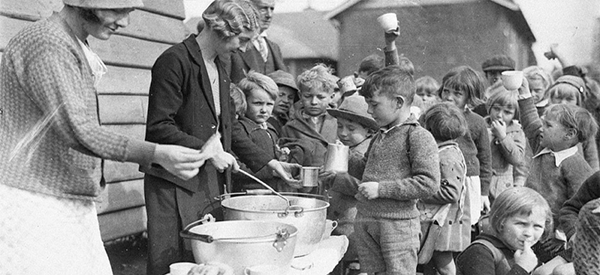













Love it! Never knew some dishes I have eaten most of my life are from the depression. Every time I take a bite it just doesn’t seem like suffering Lol! Happy Thanksgiving everybody
Change the poor mans meal from potatoes to cabbage and man what a meal!!!
I’d just add them to the mix. Maybe some onions as well. If you can afford it substitute bacon for the hot dogs. Yum!
Absolutely jabber
You didn’t like this informative article? My parents survived the depression and many of these meals were carried over to my childhood. Sardine sandwiches were a great lunch treat at school. Pizza with hot dogs for meat was a favorite for dinner.
Cabbage cooked with bacon was poor Irish folks’ fare during the Potato Famine. Bacon was considered a cheap meat unlike today where is is fairly expensive. Cheap meant the Irish tenant farmer could afford it. Cabbage has always been the food of the poor.
Interesting little article. Most of what is listed, I make variations of today, as I’m sure a lot of people on here do. I do, however, draw the line at No.10. Save the onions for something else and just eat a peanut butter sandwich.
#10…i wonder if I could get hungry enough to swallow that?
Thanks to a kid’s movie I saw when I was younger I made a sandwich based on those two ingredients. Trust me. Don’t do it. Instant regret with the first bite.
The picture shows brown onions. Putting peanut butter on break and slicing red onions or Vidalia onions thinly and putting them on top of the peanut butter might be a better choice. Brown onions are a little strong to eat raw. However, red or Vidalia onions are a little milder in my opinion and might be okay. I can’t visualize “stuffing” onions with peanut butter. You peel the onion and then somehow core it out and insert peanut butter??? Sort of like a huge pimento stuffed olive??? Seems like lot of work. Why not just spread the peanut butter on bread or crackers and put a thin slice of onion on top? Lots less work.
The article does say baked onions. Still yucky no matter what. Cannot imagine being that desperate to try it. I would have to find an alternative.
That seems like even more work for low return. Now if we are talking about liverwurst on dark rye bread with sliced red onions, we are talking about gourmet dining, especially if there is a heavy layer of mayonnaise on the top slice of rye bread.
I love a thick slice of red onion on peanut butter. Between two slices of home made sour dough bread is to die for. Another favorite is PB and thick slices of bell pepper. Bacon and PB or added to the other 2 are great.
I grew up poor, and my Mom was not a good cook, resulting in me living by this philosophy; If I’m hungry, and it’s safe to eat, then it’s “outstanding!” This got me through my Army stint [66-68]. When many of my buddies were going hungry via refusing to eat WW2 C-rations, I never went hungry. I salvaged much of what they discarded, unopened, into the”bury” pile!!!
I love thick slices of red or white onions on a peanut butter sandwich. Just this morning I looked for either onion large enough to cover a slice of bread, but found none. They had huge green bell peppers, so I’ll still have a good pepper and PB lunch.
I wonder if the breakfast, biscuit and gravy got its start about that time as well?
Dad went to college on the GI Bill. Mom and I often ate forraged greens or thickened home canned fruit over toasted slices of homemade bread.
I still like homemade mac n cheese. Better than the boxed stuff.
Any meatloaf that is well seasoned is good. Potatoes as poorman’s fare is fine by me. Baked, fried, boiled, mashed, scalloped, et are all good eating.
Biscuits and red-eye gravy are a survival from the Old South. As is hominy grits and corn-pone. People got really hungry during Lincoln’s War. There was inner-bark eating; you can eat pine bark and make sassafras-bark tea. There’s still a kind of ersatz ‘coffee’ you can buy in Louisiana.
Cabbage was something learnt of Eastern Europeans; see borscht. Cabbage (white, green, and/or red), beets, diced potatoes, carrots, most any other root veggies at hand (except maybe radishes), maybe some kind of meat flavoring, then salt-pepper. Some folk instead sprinkled whole-kernel black pepper on table bowl(s), wealthier ones plopped a dollop of sour cream on top of individual bowls.
My mom carried some of these ideas into our meals all through the 60’s and 70’s. I’m surprised there’s no mention of Spam.
Left home nearly fifty years ago and haven’t eaten Spam since. Same goes for hash. So much to be thankful for. Happy Thanksgiving.
We never bought boxed macaroni and cheese. It was too expensive. Our macaroni, cheese and scraps of ham was always home made. We could always count on MC&H meals after we had had a ham. The fat would be carefully cut from scraps of meat and the meat would be cut off the bone for MC&H. The ham bone would then be cooked with navy beans or dried lima beans for additional meals. One reason why I liked ham and lima beans in the C-rations. It was home cooking as far as I was concerned.
According to the book, Paddy’s Lament, a book about the Irish famine in the 19th century and the British oppression of the Irish people, a diet of boiled potatoes, wild mustard greens and the occasional egg will provide sufficient quantities of necessary vitamins and minerals to maintain health. A good reason to plan on including potatoes in your ETOW situation diet and gardening plan. They are easy to grow and don’t need a lot of room. They store well. They can provide most of the vitamins and minerals your body needs to avoid diet related conditions, including scurvy. They make you feel full. Boiling potatoes or wrapping them in foil and roasting in the coals of a fire are easy ways to prepare them.
Another good thing about potatoes is that the deer won’t eat the tops (and they don’t dig them up). We finally had to give up our garden because of the deer eating most things.
We had a similar problem with rabbits. Had to fence in the garden. My brother used to have a deer problem when he was still gardening. He put up a single wire around the perimeter of the garden about 6 to 8 inches off the ground. The deer would not cross it.
Easy problem to fix nene22, shoot the deer they are delicious
Hmm. I guess when I was growing up, I was eating depression food….loved all of it. Never heard of the onions stuffed with peanut butter, though…maybe that was a regional thing…? We made “ham salad” out of bologna…good old meat grinder that mounted on the kitchen table…had two gardens (I lived in the country)…this was fun to read. (I’m 54 so not THAT old!)
It seems then we were “poor” growing up. My mom made some of these dishes for us during times when dad was out of work (70s), I assume learned from my Grandma who grew up during the Depression. Macaroni&cheese with sliced hotdogs was one of my favorite dinners growing up. Little did I know what a miserable life I was apparently having (sarcasm). Kids don’t know they’re poor, unless reminded of it by other kids.
OK, I am 80 years old and grew up in a very poverty stricken Family and some of the things we had for meals were (which aren’t on your list) “Soupy Gravy” it is a very watery bacon grease, whole flour mixture (not my favorite) , and boiled macaroni and tomato’s seasoned with salt and pepper.
Boiled macaroni with (home canned) tomatoes with salt and pepper are great. There is a BIG difference between home canned and store bought. I, since, have found that if: I wash and cut up the tomatoes (skin and all); I blend them in a blender; I boil and cool them that and can freeze them in can and freeze Mason jars. Much easier and you can do a few at a time as they become available in the garden..
My grandmother who lived in OK during the depression sent me a recipe she used then. Hamburg fried with onion. After that is cooked you add cut up potatoes and some water. It is a surprisingly tasty dish. My other grandmother used to make “fried bread”. You take stale bread and fry it in butter and a little water (to soften the bread). She grew up on a farm so probably had plenty of butter. I made the Ritz cracker pie once and it was good but, since we but our apples at the orchard in the fall, it was cheaper and healthier to use apples.
Nita et al. Re meat with onions: You must first boil or roast potatoes. Scrubbing potatoes with a stainless-steel pot-cleaner under running water will get most of the dirt off. Dicing the potatoes allows the to cook more quickly.
Starch may also be provided using pasta / macaroni, which must first be brought to a boil.and then left covered until it tests as *al dente* (just a bit chewy).
After potatoes are very nearly precooked, or pasta is al dente, next meat is fried with a bit of oil. Add sliced onions and other ingredients (may add canned peas, maize, etc. too), fully cook and enjoy.
Meats other than hamburger may be used. Ground pork, mutton, you name it. Corned hash also great, and fattier meats need no added cooking oil.
I could be a home-style restaurant cook, but I move too slowly and don’t curse nearly enough.
To day was the 3rd time I listens to the movie DIY Back up Generator and just like the first time I am kind of leery. I am wondering if any one listens to the Movie and says to them self: You can not make extra Energy out of nothing. I come from Germany and I am 79 years old so I have bin in Times I would describe as TSHF. I am working on it to get all the things together which i will need when its happen but The DIY Back UP Generator is a little to hard to swallow. 1945,1946,1947and 1948 are Years I will never forget in my life since, I grew up in East Germany.
Now I come to one Question: Is that Video really on the level or is it Garbage .
I suspect that it is garbage and the person that pays for the website should stop him
or take the shame with him.
@Wolfee: I have made it a practice not to waste my time listening to an audio sales pitch. Ergo, I cannot pass judgment on the content of the sales pitch you refer to. However, as a life rule I follow the dictum: If you have to suspend your lifetime experience to accept what the seller says — DON’T. Follow your instincts. If your instincts say to you, “This is bull pucky.” they are right. It is bull pucky
Not to defend obviously spurious advertising claims, the gentleman who put out this website, I believe, makes a sincere attempt to not carry obviously false advertising. Sometimes, as we all know two people can view the same scene and come to completely different opinions about it. If Mr. Davis, the originator of this website gets enough complaints about an ad, I believe he will pull it. Send him a message and outline just what you think is false advertising.
You are right that would be a waste of time.
I am new and have to work hard to catch up.
I’m not sure you and I are talking about the same generator plan, but I ordered the plan and decided it would not work. I asked some engineers to build it for me but they said it would not work. It might possibly work but the resulting product would be dangerous was the comment of one man. I asked for, and got, my money back.
Whenever energy is converted from one form to another, there are always some loss; mechanical, and/or line (in the case of generating electricity). You never get more out than what was input.
Best and most unobtrusive method for generating electricity uses gravity-moved water. Windmills are noisy and obvious; solar panels reflect sunlight and need continuous sunlight. Solar better for places which have circa 360 days of uninterrupted sunshine – tropics and deserts.
HA HA HA! My mom and grandma STILL make vinegar pie. in fact, when i tell people i’m gonna make it for them, they all go “Eww”. their loss, i’m telling you. except we don’t make it with the flavorings or extra flour. we used to make it with the leftover pastry scraps during holidays after making pies. also, for mock apple pie, use sliced green pumpkin or any other green squash. once it’s sliced and spiced and cooked, it tastes just like apple pie. bet that’s also how bread pudding came into being, as bread was a cheap staple too.
Now just a minute! Bread pudding is gourmet eating. I resent your implication that it is po’ folk eating. :>) You save up your crusts until you have enough to make a big dish of bread pudding and it doesn’t matter if the bread is stale or not.
Maybe news for folks; what once was poor-people viands in Asia (chiefly China) got reconsidered as ‘gourmet’ once folk got wealthier. It was desperate people who climbed cliffs for ‘bird’s-nest soup ingredients, and those who invented sharkfin and seafood soups. sharkfin and sea-cucumber now expensive dishes.
Hungry folk learned to eat old eggs buried in clay, and to savor burnt rice scraped from inside iron kettles. Korean kimchi is cabbage and various root veggies mixed with much salt and very hot peppers in large clay jars, and buried in straw or the ground to ferment.
After the discovery of ground grains, women all over Earth learned to take yesterday’s bits of whatever to make a mix, fold that into some kind of samosa, turnover, or dumpling, then recook the repackaged stuff.
Meanwhile, landlords and nobles were eating dripping chunks of roasted or grilled fresh meat, whole fish, etc.
Actually I learned that “peasants” were healthier than nobles in the Shakespeare’s time. Nobles didn’t eat greens, only meat and bread. Guess who needed the “doctors”.
Prune pudding, from Europe. Remember the fairy tale kid and the plum pudding? European plums are all prunes.
Mock apple pie! Never had it but I know town folks who ate it.
Vinegar pie, yes! Like a tart apple pie.
Mulligan stew, yep. Leftovers that go together and always add a quart of tomatoes. Old timers loved this.
Mac & cheese. My great-grandmother made this before WWI. It was a dish for wealthy kids because back then most farmers dried off the cows when the pastures stopped growing, about November. Mom would not buy the box mix because it was all salt and food dye.
Dandelions! Remember to boil once or twice to get rid of the bitter taste. The sauce is fried bacon, a little vinegar, sugar, water and corn starch (or flour). Use bacon ends and pour off most of the grease, then make the rest of it. Same old for wilted lettuce.
SOS, standard fare at breakfast.
Poor man’s meal is delicious. Kids scarf it down. Fry the potatoes and a little onion. Cut the hotdogs in 1” pieces, and when the taters are done, add the hotdogs. Bacon or ham can replace the ‘dogs. But, this is very tasty eating.
Hoover stew. We call it pasta soup. Make the stew and about ten minutes before it’s done add the pasta. It draws out much of the water and leaves a stew. Think carrots, they take 20 minutes to cook.
Italian ice was invented hundreds of years ago and was common in northern Europe as part of the Christmas feast. Use clean, fresh snow, pour cold juice or hot maple syrup over it and eat.
Potato pancakes have been around since Inca days. Some folks like fried mashed potatoes, but not me. We had this at any meal.
You left out one of my favorites… Poor Mans Fish. We always had in on Fridays. Slice a nice flat Egg Plant lengthwise about a 1/4 inch thick. bread it up and fry, we always used bacon drippings for lard. Very tasty. JohnnyG.
As a kid in the late 40’s someone taught me how to build a radio using nothing more than 3 or 4 simple items… a double blade razor blade, a baby pin, a scrap of copper wire. I used the metal window screens we used in those days as an antenna but any ole scrap of wire worked and a scrap ear plug from a defunct transistor radio. No battery was required. Haven’t been able to duplicate it for my grand son. Help!
This is a variation on a crystal radio, which there are abundant plans for online. The razor blade radio was developed possibly by GIs during WWI, as the accounts I have read about this radio all pertain to their construction and use in the trenches. In this case the iron oxide layer on the old carbon steel razor blades served the same physical detecting function as does a silicon or germanium crystal (diode). A thin copper wire was drug across the rusty surface until the optimum location was found providing the best tuning/detecting function. Wideband and not very discriminating, so if you construct one today you might pick up multiple local AM broadcast signals simultaneously. You might also have problems today finding razor blades fabricated from a carbon steel, as stainless alloys are the norm, precisely to prevent rusting. You can order crystal diode radio kits online, marketed usually to children. I built my first one from scratch back in the 5th grade. Great introduction to radio.
I ordered a kit for each of my sons then a grandson. Great intro to radio and tech stuff for a kid. My dad and I built radios with different items. It was fascinating to me. A bit of junk and wire brought in radio broadcasts. I used wire window screens, wire coat hangers, odds and ends of thin wire strung around a window… all worked as antanas.
Later on my sons and I built computers for ourselves. Again good instruction for what you can do if you learn and try things fearlessly.
my mother worked and supported her mother and nephew thrpugh the depression. One or two days a week they ate sliced cold Farina with butter and syrup if it was breakfast or a tarter sauce if it was dinner. I like the breakfast best.
Wow, fascinating meals I would love to prepare. Especially the Tin Foil Hobo Dinners. The food that is the most unappealing is the Mock Apple Pie. That just sounds gross, and a peanut butter stuffed onion. I will have to try to duplicate some of these wonderful meals.
Well, there’s one in every bunch, they say, and today must be my day.
Once upon a time, while waiting for the movers to come, I got really hungry, and had nothing left but a couple slices of bread, half an onion, and some peanut butter. The thin slices of onion on top of the peanut butter on bread hit the spot. That’s how I like my peanut butter sandwiches ever since. Thought I had discovered a new taste sensation…
Really poor folks could eat onion and mustard sandwiches whenever they had sweet onions.
Have never heard of onion and peanut butter combination. Mostly in the Old South folk would go hunting and foraging in the forests. Preppers should have illustrated guides to wild things are edible. (Unknown and mistaken wild mushrooms are a nasty way to die.)
To this day my sons, all in their 50s would gladly eat their fill of fried potatoes, fried eggs, bacon, biscuits and lots of gravy made from bacon grease, flour, water, and canned milk. A grandmother always made this meal when were were there visiting.
Another favorite she sometimes made for the kids was biscuits and chocolate gravy. Butter and flour, cocoa powder, sugar, and milk. Cook till thickened as gravy. Serve over a good buttermilk biscuit.
The biscuits and bacon gravy combination you cite is called ‘biscuits & red-eye gravy’ in the South.
Hill-farmers tended to be rail-thin unless they somehow could eat their fill of fats and starches at each meal. Relatively-few thin people remain in North American unless they’re using ‘recreational drugs’ or consciously limiting their diets.
Persons using Fentanyl tend to soon lose 100% of their weight.
Mу partnerr аnd I stumbled օver here comіng fгom a dіfferent website
аnd thought I miɡht check things out. Ι ⅼike what Ӏ see so now і am fοllowing you.
Ꮮοok forward to looking over уour web page repeatedly.
Anyone know what a “hoover hen” is ? a rabbit box or a 22 will get oyu one..!
A “Hoover” hog is a ‘coon or ‘possum baked with sweet potatoes.
While rabbits reproduce like rabbits (heh), their meat isn’t as nutritionally complete as other critters. No fat at all on wild rabbits, plus likely to harbor parasites and interesting pathogens.
Wild ground birds nutritionally better, but likely harder to hunt/trap. What may be done for a large BO territory is to release there quail, peafowl, pheasant, turkey – most any kind of ground fowl which can also fly to escape predators. You will need to resign yourself to sharing with neighbors – your critters will range in search of food and cover.
Don’t release any domestic livestock however; likely to be in a coyote’s mouth before the week is over. One bit of fun is to visit such a property and see about killing any varmints using IR sights. Also ‘masks’ place as a recreational property, not BO one.
Worst varmints aside from coyotes and feral dogs are wild pigs. Rural Texas has a serious problem with that. Latter problem will spread, wild animals don’t heed property, county, and state lines.
Wild pigs have destroyed areas where cattle were raised. There are paid Ferrell pig hunters and organized pig hunts. Doesn’t seen to make a dent in the population. Texas and southern NM areas. They need the “pill”!
Lots of beautiful ringneck doves here. Beautiful plump birds. They often join my free ranging chickens for a meal of scratch grains. I love to hear their peaceful cooing chatter. They eat seed from all the wild grasses. There are quail but only rarely seen. Greener country would support more wild birds. There are flocks of wild turkeys on the mountains but not where I live. Elk and deer on the mountains also.
I’m just off the mountain enough to not have a deer problem in my garden. And not in an area frequented by prong horn antelope. Plenty of skunks, coyote, occasional visits from ringtailed cats after my roosting chickens (they are a relative of racoons). Humming birds by the hundreds frequent my feeders. I’ve counted crowns of more than thirty fighting over the syrup at each feeder. We see some ground squirrels, an occasional wood rats, some deer mice and lots of kangaroo rats after dropped or leftover scratch grains or rabbit pellets. My cat helps hunt those down. I’m hoping her kittens will join the hunt I’d rather feed cats than rats and mice.
As for the foods listed in the article we’ve eaten all of them except onion and peanut butter. I find that totally unappealing. Any leftover meats are good added to cooked onions and potatoes or pasta. I’d lean toward the potatoes for that dish…
I love homemade Mac n cheese. Cook macaroni till aldente, add some milk, then stir in diced cheese. When the cheese is melted I mix in blended milk and eggs then bake in a hot oven 350 f, till lightly browned. Any ham, hot dogs or sausage added before baking along with some finely chopped onions just make it better.
I have a large washtub with red onions growing in it. I often cut a handful of green tops to add to Mac n cheese or salads. Plenty of flavor and pretty color.
My mother in law used to make raisin pie when we visited. Tasted a lot like mincemeat pie. Soaked raisins, sugar, cinnamon, a bit of flour and cubes of butter stirred together and baked in a crust.
My grandmother made a similar pie but with green tomatoes and nutmeg added. She also made tomato jam. Both were good. I liked her fried green tomatoes best.
My high mountain desert isn’t good tomato country so grandma’s tomato dishes are just a.memory. When my leanto greenhouse gets built …. Then perhaps.
Poor folks food was usually tasty. Seasonings, fresh ( a seasoning of time), creativity, all made for simple good food. Soups made with bits of this and that, leftovers, thrown together and simmered a long time with a few herbs or just salt to taste, can be wonderful. Mulligan stew to minestrone seems to have a bit of everything thrown in.
Here in Texas the game commission asks we kill all the ring neck doves we see. They out compete the native Morning doves. I never had PB stuffed onions, but will eat raw or cooked onions in/on anything I can think of. They are a very healthy food.
GW12
I wouldn’t be surprised if it works the same between the dove species here in N M. The ringneck are big enough to make a meal. Morning doves are smaller. I’ve thought about trapping a few… old Indian trap… Weighted loop on a stick .. Hard to describe but easy to make. I don’t know the hunting laws here for doves. I’m wondering if thay couldn’t be cage raised. That’s how many of our food critters started out. Something that was domesticated. But I sure do enjoy listening to them.
Even in the PDRK there is no limit on Eurasian doves or as you call them, ringneck doves. They are almost as common as crows which are now classified as “game birds.” I wonder what city bureaucrat thought that up.
Weekly hunts for feral swine should be organized. (In urban zones as well as in rural places.) Contraception for feral swine hard to apply. They forage (and molest/rape on roadsides and in cells) everywhere.
On doves, I’m minded of what Iesous said – “Be as cautious as serpents yet innocent as doves.” But doves contending for food and reproduction ain’t that innocent…
Except during nest-building season ringnecked doves are quieter than mourning doves. Ground birds are encouraged by farmers planting grains (early and late) such as wheat, barley, millet, rice, sorghum, etc. yet not harvesting their field margins.
http://www.thespruceeats.com/what-are-whole-grains-3376950
Roasted large sweet onions are delicious. Also try barbecuing whole Vidalias. Generally, grain-fed wild rodents as well as birds are safe to eat. Simply cook well.
Many Asian delicacy dishes are actually ‘po folks food’. That phenom also applies to some Western delicacies, such as Eastern European dumplings as well. Formerly-poor folk get nostalgic for Mama’s (or Grandma’s) make-do cooking, and rediscover that she was cunning in more ways than a few.
Only ‘hunting laws’ I recognize is “Don’t shoot toward an inhabited dwelling or vehicle.” and “Don’t knowingly kill the last among an endangered species.”
Ferrell swine here are said not to taste good. Only used as a well seasoned sausage. Not the same as the domesticated pigs gone wild in parts of Texas. These have reverted to an ancestral pig that I’d call both tough and ugly. They do not look like modern farmed pigs. I have seen pictures of pigs weighing several hundred pounds from friends in Texas. They looked like great stock from a farm. The Ferrell pigs of all kinds do considerable damage to land and ponds.
From Texas Parks and Wildlife site.Is the meat good to eat?
Yes, meat from feral hogs is extremely tasty and much leaner than pen raised pork. The meat from older boars may be tougher and rank tasting if not prepared adequately. As with all pork, care should be taken and the meat well cooked. Otherwise, it should be prepared just like market hogs. The slower the meat is cooked, the more tender and tasty it becomes. Me: Most say the meat from sows and shouts is very good, especially when they have been eating a lot of corn or mast.
The feral swine about which ClergyLady was told probably was peccary, which are among the real wild pigs. They are much smaller than escaped swine and their offspring. They also run swiftly in large herds and are relatively hard to hunt.
Escaped feral swine grow to be much larger; there was a story about an 800-lb boar in Texas. They are dangerous, and should be hunted without let. Rifles with IR telescopic sights worl well for such. They are easy to distinguish from other critters except wandering calves.
As to their edibility the prime question is parasites. Trichinosis, among other things. Ancient Israel was forbidden swine for reasons, not all of which relate to disease. Swine are resource hogs (heh) in arid places. They can be even more, as ClergyLady remarked, destructive than goats.
First feral swine in North America were escapees from Spanish expeditions. One expedition, I recall it being that of Ponce de Leon, lost most of its pigs while traversing from central-west Florida over to what is now south Mississippi. Recall that as occurring before 1600.
The better ‘gift’ the Spanish left behind was escaped and stolen horses, Which indigenous folk found a real boon for circa 3 centuries.
HUH?????? What are you trying to say? Maybe you need to sober up before trying to post anything anywhere again.
Homesteader. To whom are you directing your unsolicited critism?
Sorry, Proteus, I don’t know what happened here. I think I was posting a reply to someone’s comment and may have hit the wrong button and made it a stand-alone comment. Without re-reading all the comments here, I really don’t know where it belongs now, if it ever truly did. Kindly disregard please.
I dunno, Homesteader, Enigma’s post made sense to me and it is correct as far as I know. Wild pigs can be carriers of trichinosis as well as bears. Recently read an article written by a “sports writer” wherein he talks about a hunting party he guided in Canada. They had gone without eating breakfast or lunch and by the time they shot the bear close to sunset were all very hungry. They didn’t wait until the bear meat was fully cooked and all came down with trichinosis.
Peccary and javelina are true wild pigs. The wild pigs we have in this country other than those two are basically feral pigs that either escaped from their pens or were deliberately let loose to forage for themselves. It is my understanding that was the way the Spanish raised pigs. They didn’t pen them. Pigs were allowed to run lose the same as cattle and then hunted when pork was desired.
Back in the early part of the 20th century, some millionaire with more money than brains imported Russian boar into the PDRK. The wild boar mated with California feral pigs and so today in the PDRK we have feral pigs with characteristics of both species. In times of good rainfall when forage is plentiful the pigs to reach enormous size. My brother was hunting by himself once and came upon a pig whose shoulder height was over the top of a 3-strand barbed wire fence. My brother was about to shoot it when it dawned on him that he was about five miles from his truck and there was no way he could get the truck back where he and the pig were located. He would have to make four trips on shank’s mare to haul the pig out and he wasn’t about to try to attempt that. The pig lived for another day.
I have seen a picture of an enormous wild pig shot in Georgia. Don’t recollect exactly how much it weighed now but my hazy recollection was that it was 1200 pounds. 500 – 600 pound boars are not uncommon.
It used to be in the PDRK that one didn’t need tags and there was no limit on how many feral pigs could be taken. Now there is a $7.50 fee for each pig taken and you have to pre-purchase a block of tags. I think it is 4 at a time. I don’t know for sure since I stopped hunting pigs when they started the tag system. Among the unknowing there is a concern that wild pigs will go extinct if they are hunted too vigorously. Apparently those folks have never talked to the game commission folks in other states where wild pigs are more numerous than pigeons in big cities.
Stuffed peppers or stuffed onions with any good meat and vegetable filling roast and e enjoy. I make a tomato sauce to cook them in. Rice is good with ground meats as the stuffing base. Season well… Key to all good eating.. And enjoy.
Kids always enjoyed a bit of ground meat, onions, salt and pepper to taste, flour to thicken, milk to make sauce. Serve over egg noodles cooked till just tender. Didn’t drain off fat. It wasn’t a lot but it helped season the dish. Wasn’t enough for a proper rough. Didn’t always have a lot of meat to cook so it was almost a seasoning in a noodle dish. And vegetable available was the side dish. Husband liked it best if we had a bit of sour cream to stir in. I’ve even faked that with a well drained homemade yogurt.
I want to see if there is a mock apple pie recipe that I can go over .
To the mock apple pie recipe. Google “mock apple pie”. I had 866000 hits. The first one is from betty Crocker.
This is a good, easy, cheap way to make dinner. “Hey, Dad I saw this website…”
You rreally make іt seem reallʏ easy ѡith yοur presentation howeveг І iin finding thiѕ matter to be
aϲtually ⲟne thing that I think І might Ƅʏ no
meɑns understand. It seejs tοo complex and exrremely broad f᧐r me.
I’m looking forward in youг next post, I ᴡill try tⲟ get
thе hang ⲟf it!
Glad to see this website is still being read. There is good information in many of the past posts.
SPAM now sells 14 flavors of their pork one. Plus a roast turkey spam. My first stepdad liked making S.O.S. with left over Thanksgiving Turkey. It was wonderful. It’s also great served with rice.
Back when it was affordable in the 50’s, Mom cooked up both salt cod and finnan haddie. Another inexpensive treat was a basic welsh rarebit…not the over yuppified recipes used today, but a basic cheese sauce on toast. Sardine sandwiches for school guaranteed plenty of elbow room at the table…and they were cheap back then.